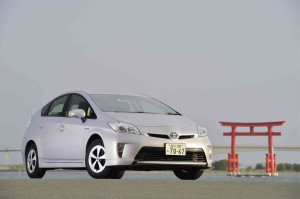Toyota, on its ‘bland’ Prius and the ‘sexier’ competition
Second in a series

By expanding the oval shape of a vehicle, one can make it look more stylish and sexier, says Toyota chief engineer Kouji Toyoshima.
Just because it’s a hybrid doesn’t mean the form has to take a backseat to function, right? And so, the motoring public needs to know: Why can’t the Prius, with its rather “bland” look, be as sexy as the luxury hybrid Tesla Model S? Okay, let’s take it even closer to home. Can the spacious Prius hold a candle to the upcoming hybrid sports coupe Honda CR-Z?
Toyota’s hybrid experts in Nagoya answered these burning issues head on.
First, the Prius-Tesla Model S comparison. Both are designed to minimize drag coefficients, yet end up having totally contrasting looks. Toyota chief engineer Kouji Toyoshima stressed that function and size do matter. He added that bigger volume is needed to make a car look “sexy.”
“Realistically speaking, when one considers aerodynamic resistance, the hatchback style is most effective. Making the bumpers edgier at the same time is another important characteristic. That’s why, for aerodynamic consideration, the current styling and shape of a Prius have become the standard. In addition to aerodynamic resistance, interior packaging is another important factor. The Prius, of course, is a compact car,” he said.
However, in the United States where the different vehicle categories are defined by their interior space, the Prius belongs to the same midclass category as the Camry despite Toyota’s classification of it as a compact car.
More stylish
Toyoshima revealed that by expanding the oval shape of a vehicle, one can make it look more stylish and sexier.
“For a smaller vehicle, if you want to achieve bigger interior space, it’s rather difficult to make the shape itself more glamorous. So, if you make the entire vehicle bigger, then you can make it sexier,” he said.
Toyoshima said that the side view of the Prius “tends to be somewhat flat, making it difficult to convey that sexy shape. Compare that to the side view of a much bigger Toyota Crown, the Crown is much sexier.”
He added: “Look at the big European sedans whose overall width reaches 1900 millimeters. If they are that wide, they can look truly sexy.”
It would be so easy to make a bigger, wider Prius, he said, effectively turning the hybrid into a voluptuous vehicle at no added cost at all. “But there are more important considerations we have to make, like the road environments in different markets and countries (that the Prius is offered in).”
In Japan, for example, if the total width of the vehicle goes beyond 1,750mm, “it would be extremely difficult for drivers to maneuver and drive their cars,” Toyoshima reasoned.
So, style does come second to function as far as the makers of Prius are concerned. But what about performance? The Philippine motoring media asked Toyoshima why Toyota doesn’t see it necessary to match the Honda CR-Z hybrid sports coupe.
His reply: “High-performance hybrids represent one possible direction for the hybrid evolution. We think that environmentally friendly vehicles can only make a meaningful contribution to the environment when they are in widespread use, and therefore, our priority is to increase the use of hybrid vehicles through basic vehicles so that when the lineup of the hybrid vehicles has expanded well enough, then we could start thinking of those high-performing hybrids.”
Toyoshima was quick to remind motoring scribes that he did not intend to pooh-pooh Honda’s efforts, “but from the sales and marketing viewpoint, it is easier to charge higher prices for high performance, but then that makes vehicles less affordable for ordinary customers. Our approach at Toyota is, first and foremost, to reduce cost well enough so that the hybrid vehicles are affordable to a wider range of buyers.”
Toyota showed 40 journalists from Pakistan, India, Philippines, Indonesia and Malaysia the automaker’s holistically green approach on managing energy in everything—including cars powering homes, and vice versa (which will be the subject of this series’ next articles).
In an article last May 29 (“Engineers address hybrids’ environmental impact,” Inquirer Motoring), Toyota discussed environmental issues surrounding the battery packs of its hybrid cars and how the auto giant has been taking the initiative to achieve full reuse and recycling of all hybrid batteries in Japan. The system of recycling/reusing batteries has also been present in the United States.
(To be continued)